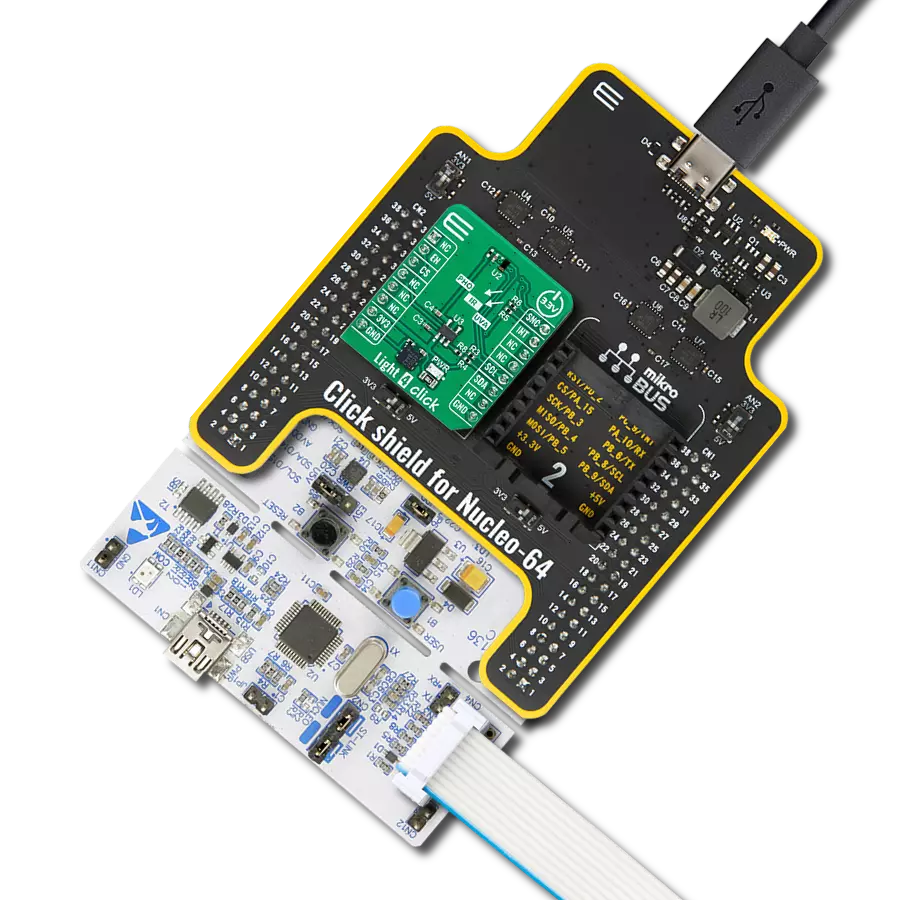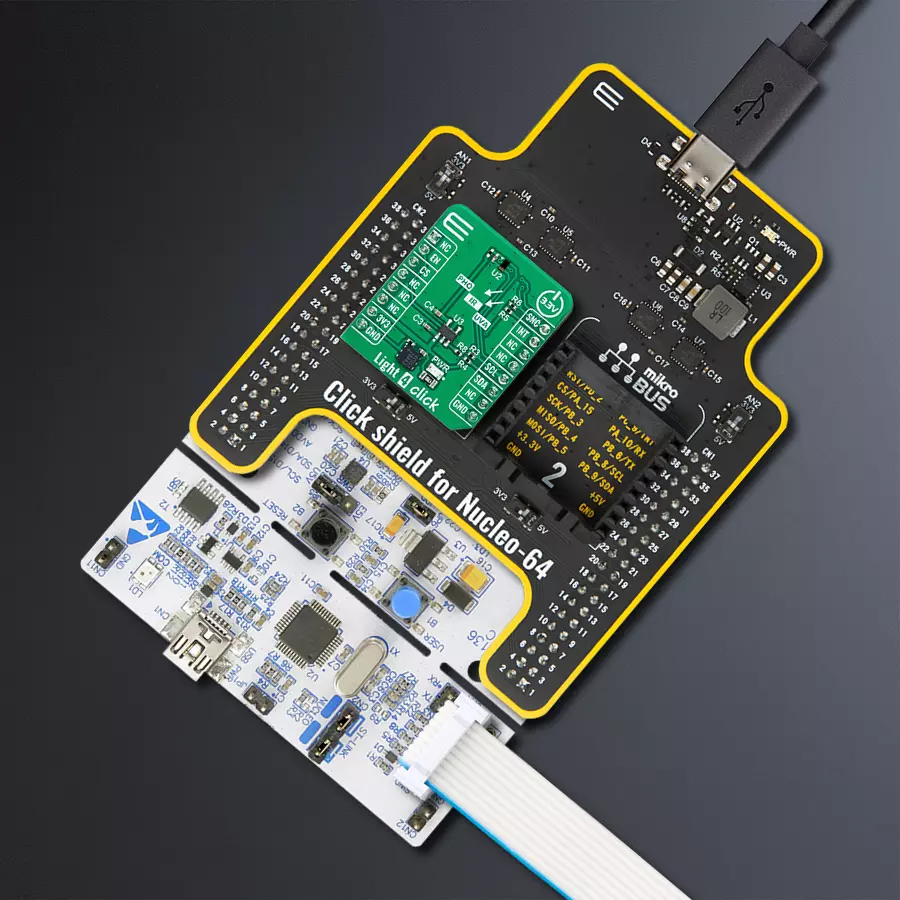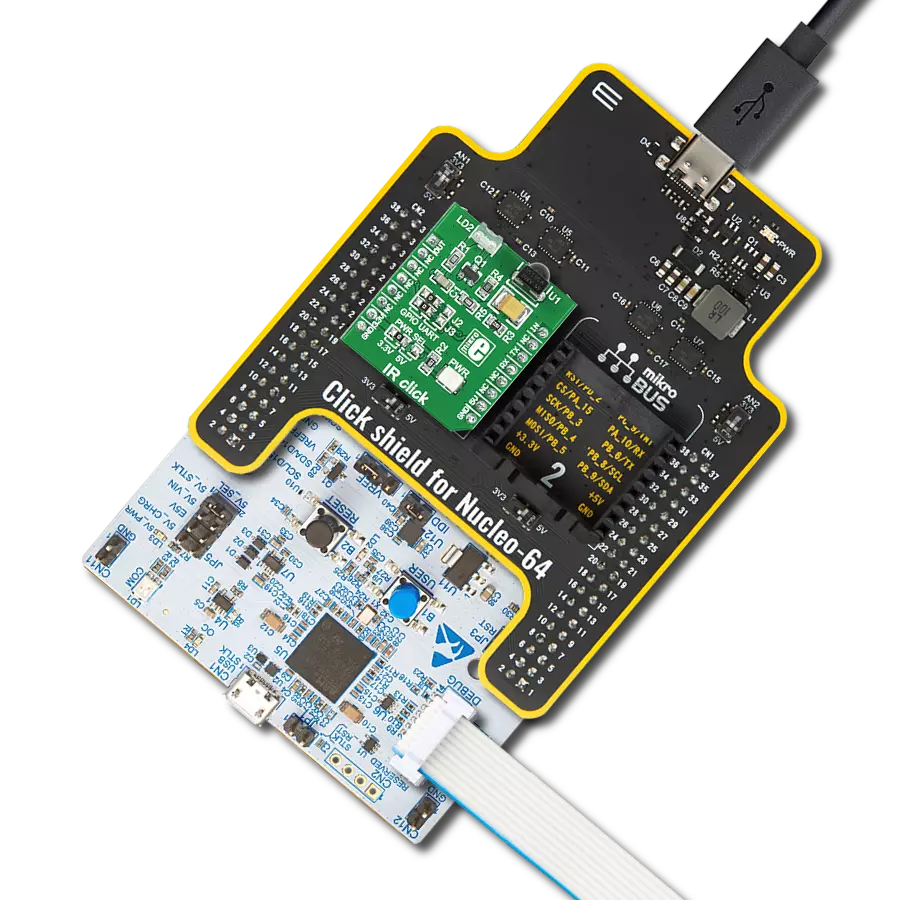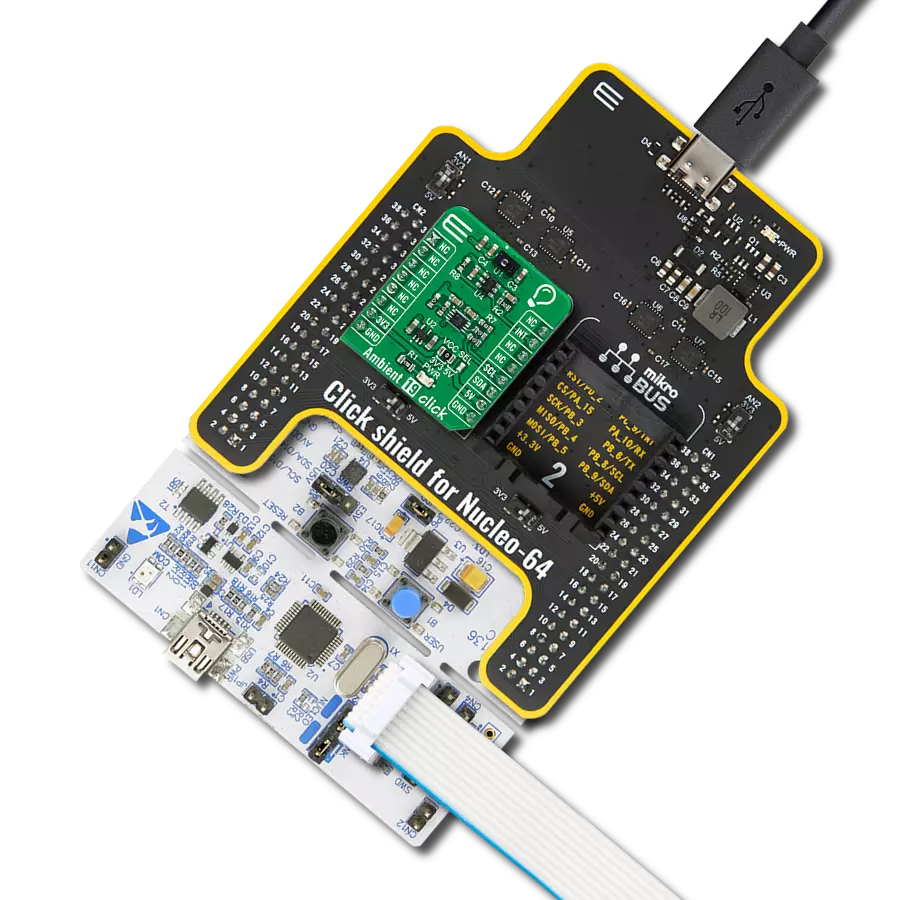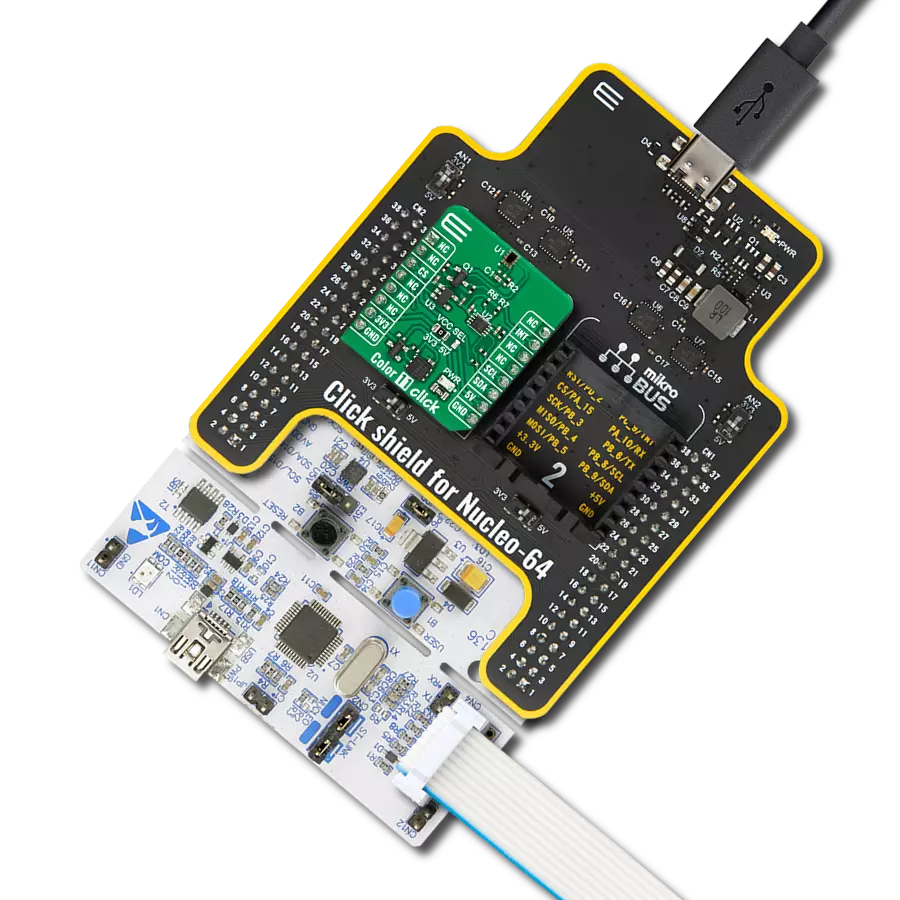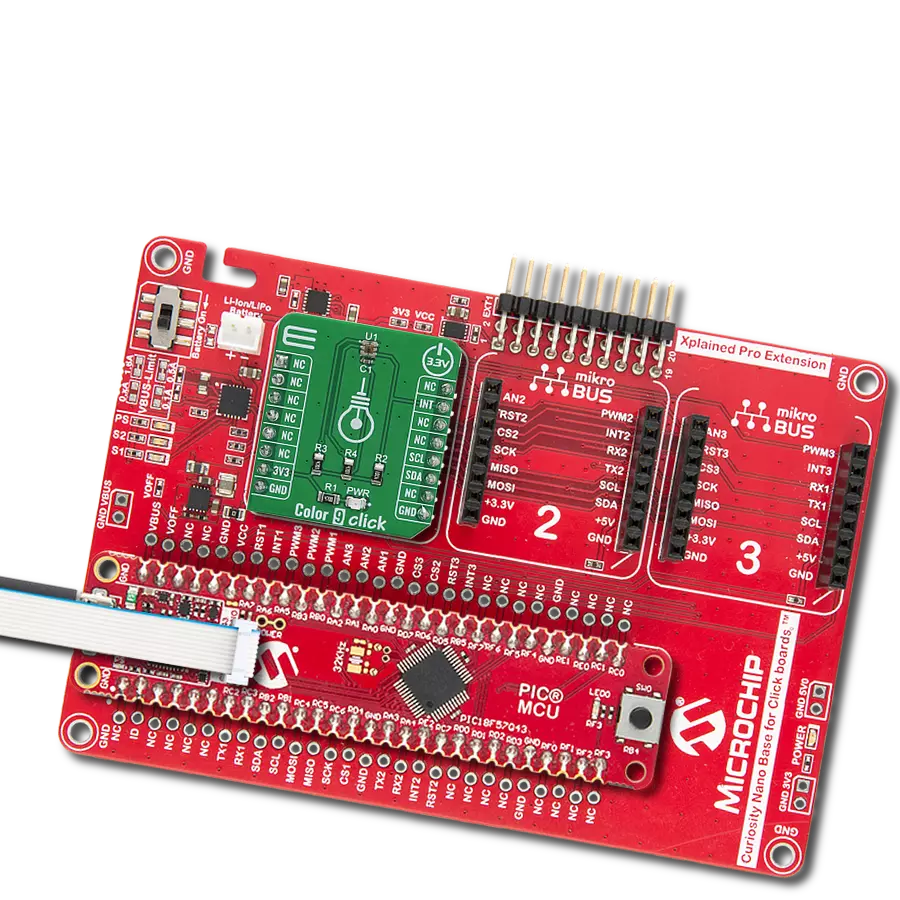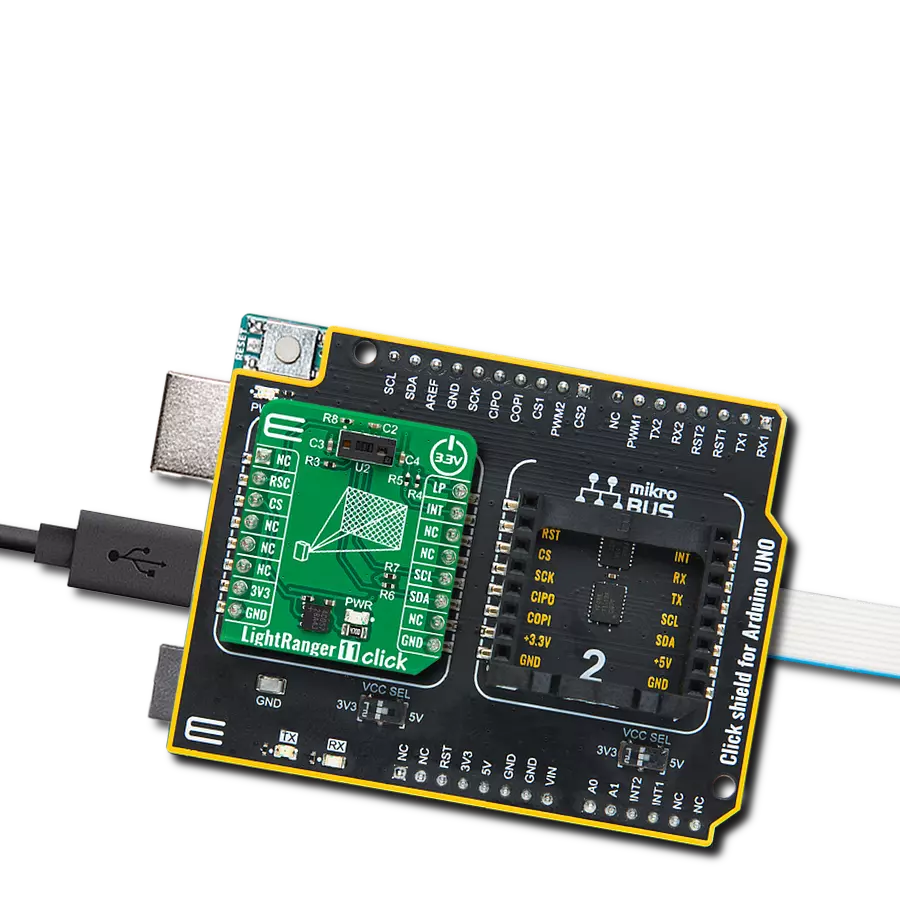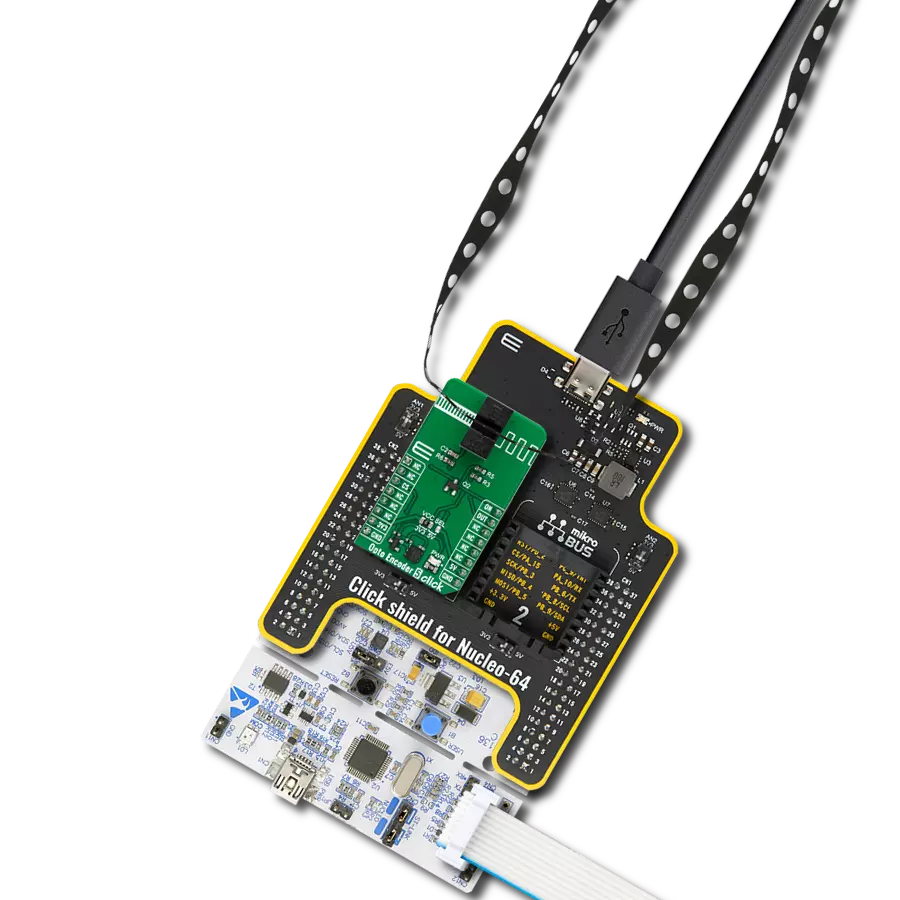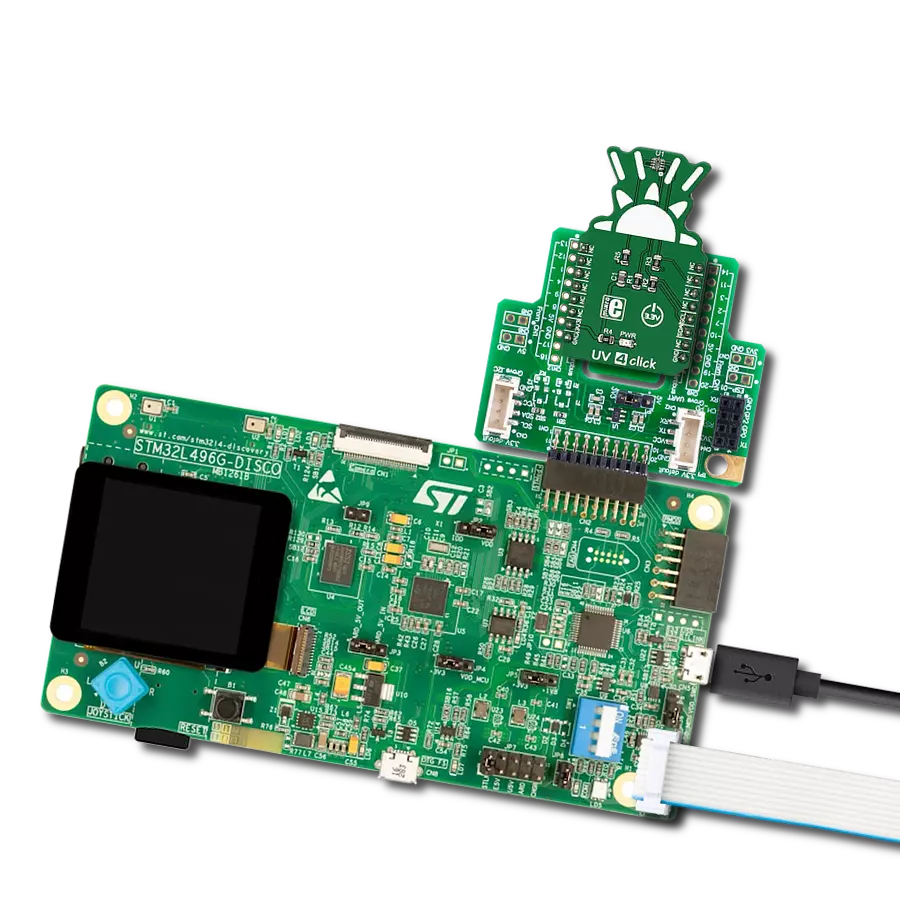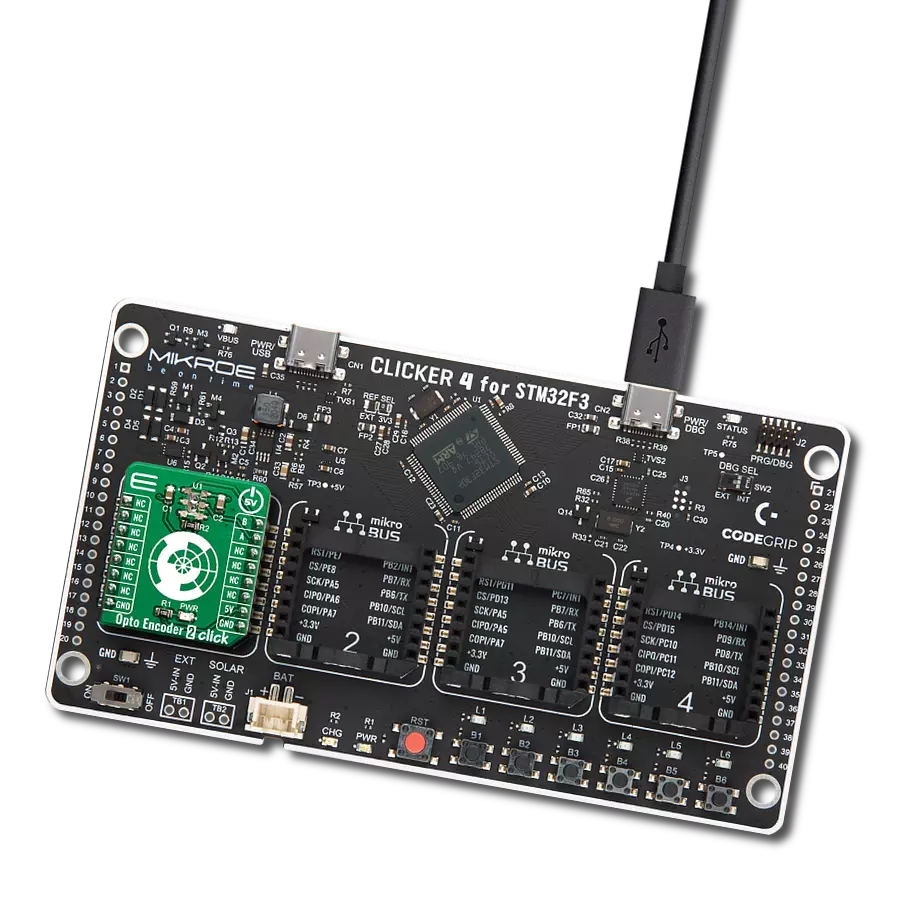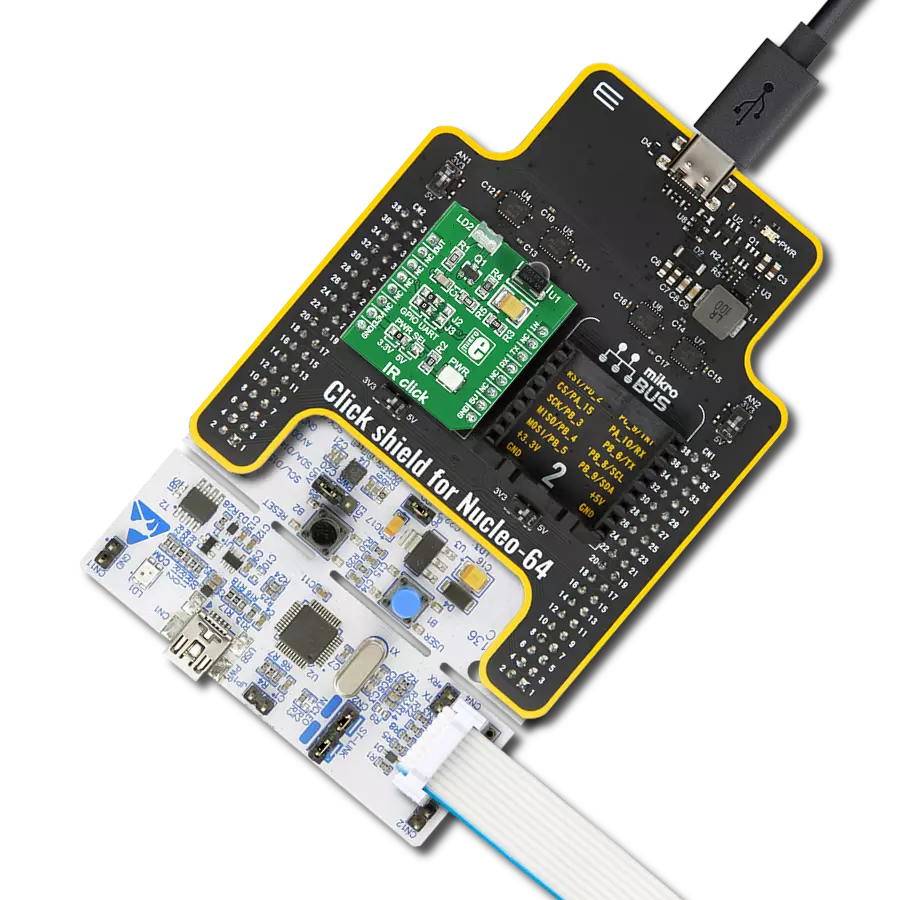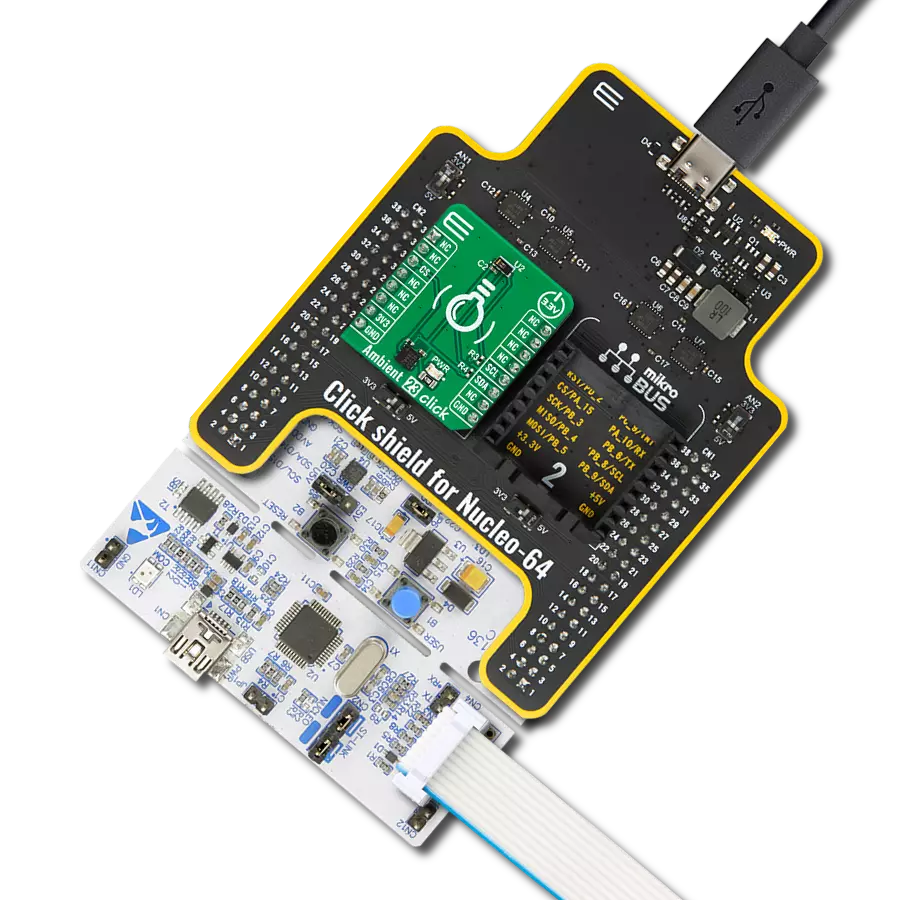Detect ambient light, UV index, and flicker with precision for optimized brightness control and environmental monitoring
A
A
Hardware Overview
How does it work?
Light 4 Click is based on the TSL2585, an ambient light sensor with UV and light flicker detection capabilities from ams OSRAM. This sensor's unique architecture incorporates photopic, infrared (IR), and ultraviolet (UV) photodiodes, enabling it to perform multiple sensing functions concurrently. Applications of Light 4 Click include automatic display brightness management in changing light conditions, UV index estimation for environmental monitoring, and camera assistance for auto exposure and flicker detection. This versatility makes it an excellent choice for consumer electronics, outdoor applications, and camera systems that require precise light and UV sensing. The TSL2585's innovative design ensures it can continuously monitor ambient light levels under any glass type. Additionally, its flicker detection functionality operates parallel with ambient light sensing, using the same photodiodes to capture data for calculating flicker frequencies. The sensor buffers this data, allowing a host MCU to process
and detect flicker from various light sources. Its photopic photodiode is equipped with an optimized filter that mimics the human eye's response to visible light, while a dedicated IR channel allows for accurate ambient light measurement and irradiance calculation of various light sources. Moreover, the UV photodiode is fitted with a band-pass UV filter, which, combined with the photopic and IR channels, allows for the estimation of the ambient UV index. An external MCU running specialized algorithms can further process this information to provide real-time UV index readings. This Click board™ uses a standard 2-wire I2C interface to communicate with the host MCU, supporting Standard mode with up to 400kHz of frequency clock. It also provides interrupt-driven events through the INT pin on the mikroBUS™ socket, triggered when ALS results exceed or fall below user-configured threshold levels. The SNC pin on the mikroBUS™ socket serves a dual-purpose function. It can be used as a synchronization input,
allowing the sensor to align its measurements with external events or signals, ensuring accurate timing and coordination in applications that require precise synchronization. Alternatively, it can also function as a general-purpose open-drain input/output pin, providing additional flexibility for various control or signaling tasks, depending on the application's specific requirements. The TSL2585 does not require a specific Power-Up sequence but requires a voltage of 1.8V for its interface and logic part to work correctly. Therefore, a small regulating LDO, the AP2112, provides a 1.8V out of 3.3V mikroBUS™ power rail. This Click board™ can be operated only with a 3.3V logic voltage level and activated via the EN pin of the mikroBUS™ socket, providing a power-enabling function. The board must perform appropriate logic voltage level conversion before using MCUs with different logic levels. Also, it comes equipped with a library containing functions and an example code that can be used as a reference for further development.
Features overview
Development board
Nucleo-64 with STM32C031C6 MCU offers a cost-effective and adaptable platform for developers to explore new ideas and prototype their designs. This board harnesses the versatility of the STM32 microcontroller, enabling users to select the optimal balance of performance and power consumption for their projects. It accommodates the STM32 microcontroller in the LQFP64 package and includes essential components such as a user LED, which doubles as an ARDUINO® signal, alongside user and reset push-buttons, and a 32.768kHz crystal oscillator for precise timing operations. Designed with expansion and flexibility in mind, the Nucleo-64 board features an ARDUINO® Uno V3 expansion connector and ST morpho extension pin
headers, granting complete access to the STM32's I/Os for comprehensive project integration. Power supply options are adaptable, supporting ST-LINK USB VBUS or external power sources, ensuring adaptability in various development environments. The board also has an on-board ST-LINK debugger/programmer with USB re-enumeration capability, simplifying the programming and debugging process. Moreover, the board is designed to simplify advanced development with its external SMPS for efficient Vcore logic supply, support for USB Device full speed or USB SNK/UFP full speed, and built-in cryptographic features, enhancing both the power efficiency and security of projects. Additional connectivity is
provided through dedicated connectors for external SMPS experimentation, a USB connector for the ST-LINK, and a MIPI® debug connector, expanding the possibilities for hardware interfacing and experimentation. Developers will find extensive support through comprehensive free software libraries and examples, courtesy of the STM32Cube MCU Package. This, combined with compatibility with a wide array of Integrated Development Environments (IDEs), including IAR Embedded Workbench®, MDK-ARM, and STM32CubeIDE, ensures a smooth and efficient development experience, allowing users to fully leverage the capabilities of the Nucleo-64 board in their projects.
Microcontroller Overview
MCU Card / MCU
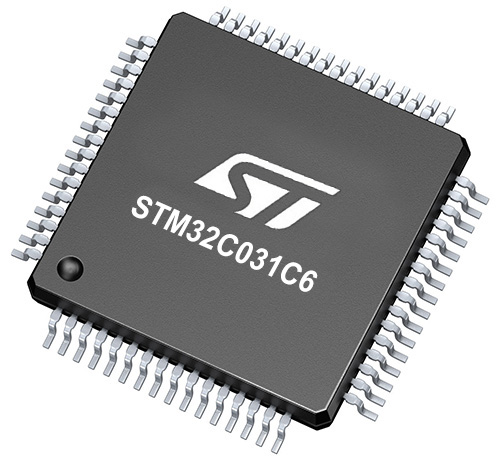
Architecture
ARM Cortex-M0
MCU Memory (KB)
32
Silicon Vendor
STMicroelectronics
Pin count
64
RAM (Bytes)
12K
You complete me!
Accessories
Click Shield for Nucleo-64 comes equipped with two proprietary mikroBUS™ sockets, allowing all the Click board™ devices to be interfaced with the STM32 Nucleo-64 board with no effort. This way, Mikroe allows its users to add any functionality from our ever-growing range of Click boards™, such as WiFi, GSM, GPS, Bluetooth, ZigBee, environmental sensors, LEDs, speech recognition, motor control, movement sensors, and many more. More than 1537 Click boards™, which can be stacked and integrated, are at your disposal. The STM32 Nucleo-64 boards are based on the microcontrollers in 64-pin packages, a 32-bit MCU with an ARM Cortex M4 processor operating at 84MHz, 512Kb Flash, and 96KB SRAM, divided into two regions where the top section represents the ST-Link/V2 debugger and programmer while the bottom section of the board is an actual development board. These boards are controlled and powered conveniently through a USB connection to program and efficiently debug the Nucleo-64 board out of the box, with an additional USB cable connected to the USB mini port on the board. Most of the STM32 microcontroller pins are brought to the IO pins on the left and right edge of the board, which are then connected to two existing mikroBUS™ sockets. This Click Shield also has several switches that perform functions such as selecting the logic levels of analog signals on mikroBUS™ sockets and selecting logic voltage levels of the mikroBUS™ sockets themselves. Besides, the user is offered the possibility of using any Click board™ with the help of existing bidirectional level-shifting voltage translators, regardless of whether the Click board™ operates at a 3.3V or 5V logic voltage level. Once you connect the STM32 Nucleo-64 board with our Click Shield for Nucleo-64, you can access hundreds of Click boards™, working with 3.3V or 5V logic voltage levels.
Used MCU Pins
mikroBUS™ mapper
Take a closer look
Click board™ Schematic

Step by step
Project assembly
Track your results in real time
Application Output
1. Application Output - In Debug mode, the 'Application Output' window enables real-time data monitoring, offering direct insight into execution results. Ensure proper data display by configuring the environment correctly using the provided tutorial.

2. UART Terminal - Use the UART Terminal to monitor data transmission via a USB to UART converter, allowing direct communication between the Click board™ and your development system. Configure the baud rate and other serial settings according to your project's requirements to ensure proper functionality. For step-by-step setup instructions, refer to the provided tutorial.

3. Plot Output - The Plot feature offers a powerful way to visualize real-time sensor data, enabling trend analysis, debugging, and comparison of multiple data points. To set it up correctly, follow the provided tutorial, which includes a step-by-step example of using the Plot feature to display Click board™ readings. To use the Plot feature in your code, use the function: plot(*insert_graph_name*, variable_name);. This is a general format, and it is up to the user to replace 'insert_graph_name' with the actual graph name and 'variable_name' with the parameter to be displayed.

Software Support
Library Description
This library contains API for Light 4 Click driver.
Key functions:
light4_write_reg- This function writes a byte into the selected register by using I2C serial interface.light4_sw_reset- This function is used to perform software reset of Light 4 Click.light4_read_channel_data- This function is used to read data from selected channel of Light 4 Click.
Open Source
Code example
The complete application code and a ready-to-use project are available through the NECTO Studio Package Manager for direct installation in the NECTO Studio. The application code can also be found on the MIKROE GitHub account.
/*!
* @file main.c
* @brief Light 4 Click example
*
* # Description
* This example demonstrates the use of Light 4 Click board by measuring
* the ambient light level in Lux.
*
* The demo application is composed of two sections :
*
* ## Application Init
* Initializes the driver, performs the Click default configuration
* and checking I2C Communication by reading Device ID.
*
* ## Application Task
* Reading channel 0 ambient light level in lux once per
* second and displaying it on the UART terminal.
*
* @author Stefan Ilic
*
*/
#include "board.h"
#include "log.h"
#include "light4.h"
static light4_t light4;
static log_t logger;
void application_init ( void )
{
log_cfg_t log_cfg; /**< Logger config object. */
light4_cfg_t light4_cfg; /**< Click config object. */
/**
* Logger initialization.
* Default baud rate: 115200
* Default log level: LOG_LEVEL_DEBUG
* @note If USB_UART_RX and USB_UART_TX
* are defined as HAL_PIN_NC, you will
* need to define them manually for log to work.
* See @b LOG_MAP_USB_UART macro definition for detailed explanation.
*/
LOG_MAP_USB_UART( log_cfg );
log_init( &logger, &log_cfg );
log_info( &logger, " Application Init " );
// Click initialization.
light4_cfg_setup( &light4_cfg );
LIGHT4_MAP_MIKROBUS( light4_cfg, MIKROBUS_1 );
if ( I2C_MASTER_ERROR == light4_init( &light4, &light4_cfg ) )
{
log_error( &logger, " Communication init." );
for ( ; ; );
}
if ( LIGHT4_ERROR == light4_default_cfg ( &light4 ) )
{
log_error( &logger, " Default configuration." );
for ( ; ; );
}
uint8_t dev_id = 0;
light4_read_reg ( &light4, LIGHT4_REG_ID, &dev_id );
if ( LIGHT4_DEVICE_ID == dev_id )
{
log_printf( &logger, " Device ID: 0x%.2X \r\n", ( uint16_t ) dev_id );
}
else
{
log_error( &logger, " Read error." );
for ( ; ; );
}
log_info( &logger, " Application Task " );
}
void application_task ( void )
{
float channel_data = 0;
err_t error_flag;
error_flag = light4_read_channel_data( &light4, LIGHT4_CHANNEL0_SEL, &channel_data );
if( LIGHT4_OK == error_flag )
{
log_printf( &logger, " Data: %.2f Lux \r\n", channel_data );
}
else if ( LIGHT4_ANALOG_SAT == error_flag )
{
log_error( &logger, " Analog saturation \r\n" );
}
Delay_ms ( 1000 );
}
int main ( void )
{
/* Do not remove this line or clock might not be set correctly. */
#ifdef PREINIT_SUPPORTED
preinit();
#endif
application_init( );
for ( ; ; )
{
application_task( );
}
return 0;
}
// ------------------------------------------------------------------------ END
Additional Support
Resources
Category:Optical
